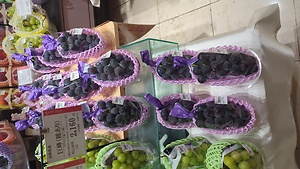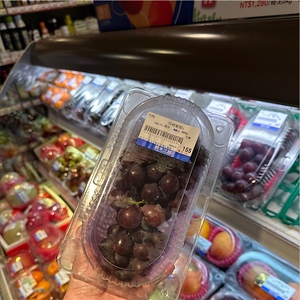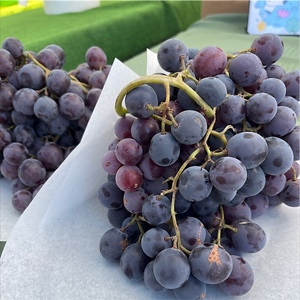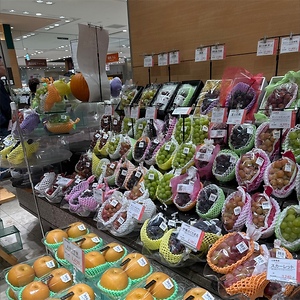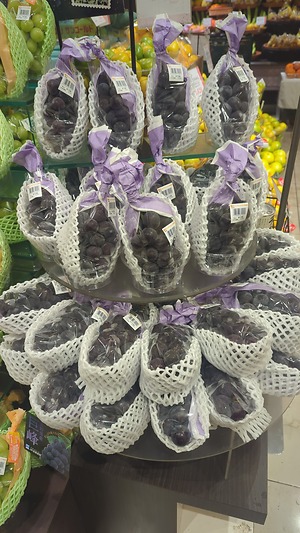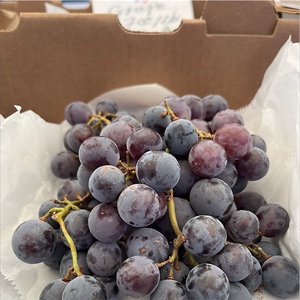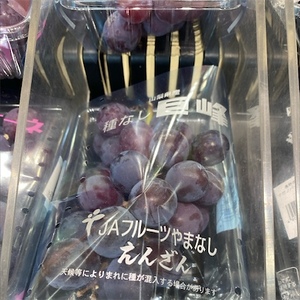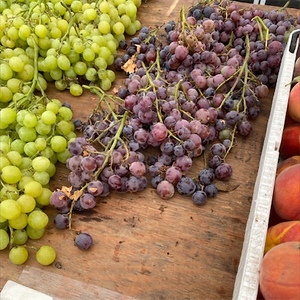


Kyoho Grapes
Estimated Inventory, 16 lbs : 0
Description/Taste
Kyoho grapes are a large varietal, growing in round bunches of dense, uniform clusters. Each grape averages 2 to 4 centimeters in diameter and has a plump, spherical to oval shape. The skin is smooth, taut, glossy, and thick, ranging in color from violet purple to dark purple, almost jet-black. A natural bloom is found across the surface, a white-powdery film that protects the grapes from fermenting and moisture loss. Kyoho grapes are a slip-skin variety, allowing the skins to be easily separated from the flesh without damage, and the skins are often removed before consumption due to their tannic, subtly bitter flavor. Underneath the surface, the flesh is aqueous, soft, and tender with a translucent green hue, encasing a few oval seeds. It is important to note that the seeds have a bitter flavor should be discarded. Kyoho grapes have a mild acidity and high sugar content, typically reaching around 18 to 20 Brix, contributing to the grape’s sweet, rich flavor reminiscent of the taste of concord grapes.
Seasons/Availability
Kyoho grapes are available in the late summer through early fall.
Current Facts
Kyoho grapes, botanically a part of the Vitis genus, are a hybrid variety belonging to the Vitaceae family. The name Kyoho roughly translates to mean "great or big mountain peak” and was given in honor of the famous Mount Fuji. Legend has it that the breeder of Kyoho grapes could see Mount Fuji outside of his window at the research institute, inspiring him to name the large grapes after the famous landmark. Kyoho grapes are one of the most popular varieties in Japan, accounting for one-third of the table grapes produced for Japanese commercial markets. The dark purple grapes are prized for their large size, juicy flesh, and sweet flavor and are a specialty variety sold at high prices due to their meticulous cultivation requirements. Kyoho grapes are primarily consumed as table grapes, eaten fresh, but they are also used commercially to flavor popular snacks, candies, and juices.
Nutritional Value
Kyoho grapes are an excellent source of anthocyanins, pigmented compounds in the flesh and skin that provide antioxidant-like properties to protect the cells against free radical damage and vitamin C to reduce inflammation while strengthening the immune system. The grapes are also a good source of potassium to regulate fluid levels within the body, dietary fiber to stimulate the digestive tract, vitamin K to assist in faster wound healing, and other nutrients including copper, B vitamins, iron, and magnesium.
Applications
Kyoho grapes have a dense, juicy texture and sweet flavor well suited for fresh and cooked preparations. The grape’s skin is thick, acidic, and astringent and can be peeled or left intact, depending on consumer preferences. Most consumers choose to peel the skin and solely eat the flesh, also discarding the bitter seeds. Kyoho grapes can be chilled and consumed out-of-hand, or they can be sliced and tossed into salads, mixed into fruit bowls, layered into parfaits, or served with salty cheeses on charcuterie boards. The grapes can also be frozen and eaten as a sorbet-like treat, blended into smoothies, or sliced and layered into whipped cream sandwiches. In addition to fresh preparations, Kyoho grapes can be simmered into jellies, jams, and compotes or used as an edible garnish over tarts, cakes, pies, and ice cream. The grapes can also be used similarly to a concord, making juice, sodas, spritzers, and sweet wine. In Japan, Kyoho grapes are often used in the traditional cocktail chuhai, which is a blend of shochu mixed with carbonated water and additional fruity flavorings. Chuhai is an abbreviation for “shochu highball,” and there are many different flavors of the beverage, including regular grape and Kyoho grape, with Kyoho being one of the only specified varieties used as a flavoring. Kyoho grapes pair well with cheeses such as feta, blue, and cheddar, peanut butter, lavender, honey, rosemary, fruits including blueberries, apricots, cherries, apples, and oranges, and nuts such as hazelnuts, almonds, pecans, and peanuts. Whole, unwashed Kyoho grapes will keep 2 to 4 days when stored in a plastic bag or container in the refrigerator.
Ethnic/Cultural Info
Kyoho grape cultivation is considered an art form in Japan. The strictly controlled growing process involves careful pruning, studying, shaping, and harvesting. As the grapes mature, the bunches are pruned to contain 30 to 35 evenly spaced and sized berries. If there are too many fruits within one bunch, it is believed that the grapes will lose their sweet flavor. Kyoho grape bunches are also molded to have a uniform, round shape and are often covered in white paper bags to prevent insect infestations, diseases, and protection from the elements. During the ripening process, the grapes are assessed continuously for their color and size, and once ripe, they are hand-harvested and carefully packaged for the market. Throughout Japan, Kyoho grapes are given as luxury gifts and are a symbol of quality and friendship. Specialty fruit parlors across the country, such as the Sembikiya Fruit Emporium in Tokyo, sell high-end fruits as presents for birthdays, anniversaries, graduations, and weddings. The fruits are presented to consumers under bright lights, modern signs, and decorative stickers in the store, similar in appearance to high-end jewelry stores. Some Kyoho grapes, depending on their cultivation, can cost over sixty dollars for one bunch.
Geography/History
Kyoho grapes were developed as a hybrid variety in Japan by breeder Yasushi Oinoue in 1937. The grape cultivar was created through the Institute for Agronomical and Biological Science in Shizuoka, Japan, from a cross between Centennial grape varieties and Ishiharawase grapes. Kyoho grapes were selected for their concord grape-like flavor and large size. The variety was released for commercial cultivation in 1942 and was named Kyoho in honor of Mount Fuji in 1946. It took several years before the variety gathered enough interest in Japan for extensive cultivation, and in 1957, Kyoho grapes became a widespread cultivar seen in consumer markets. Today Kyoho grapes are mainly produced in the Yamanashi and Nagano Prefectures of Japan, sold through luxury fruit retailers, local markets, and high-end grocers. The grapes have also been established outside of their native home in China, Taiwan, Korea, California, and Chile and are seasonally found through specialty markets, retailers, and distributors. The majority of Kyoho grapes are grown in China, and the grapes are one of the most planted varieties in Asia.
Recipe Ideas
Recipes that include Kyoho Grapes. One
| Mountain Side Bride |
|
Kyoho Smash |







